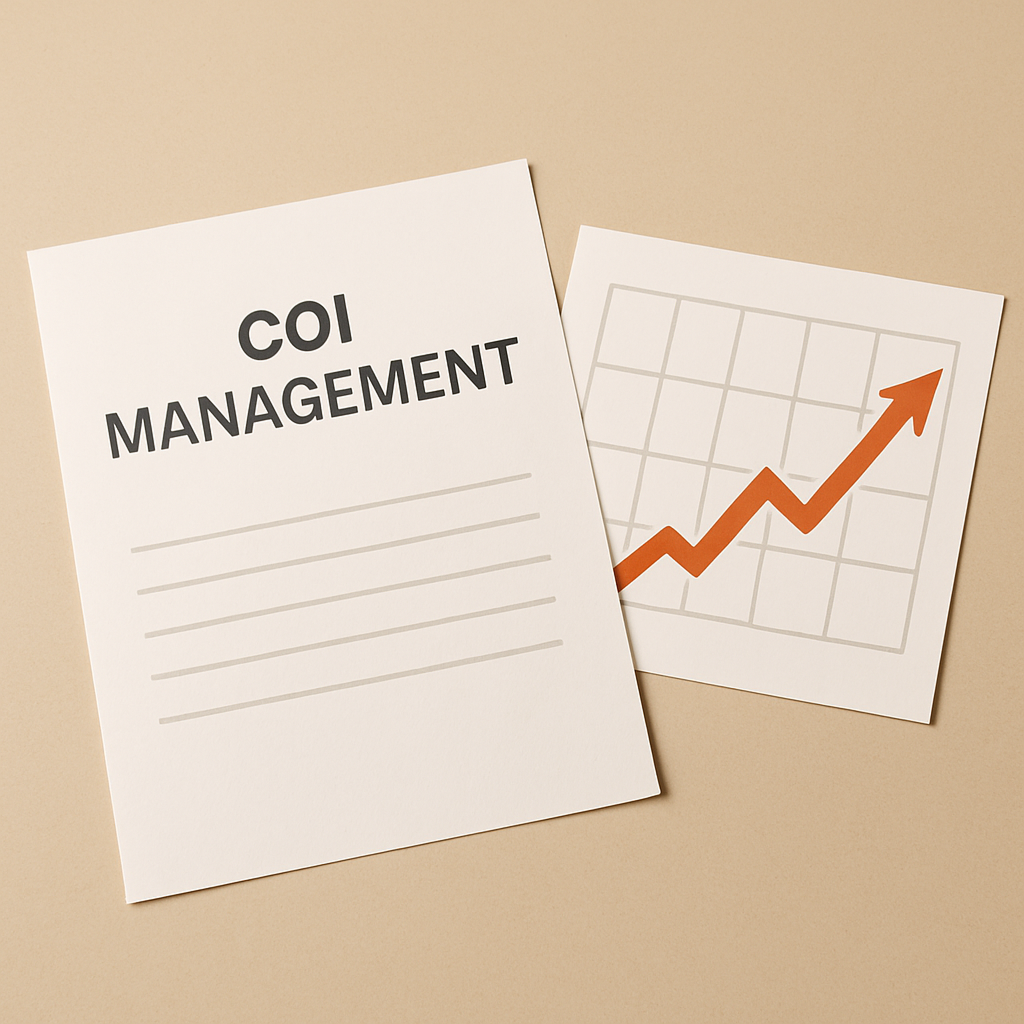
5 Trends Shaping the Future of Compliance (and What They Mean for COI Management)
Risk and compliance are evolving faster than ever. Businesses face tighter regulations, more complex vendor networks, and rising claim costs. The old way of handling compliance — reactive paperwork, manual tracking, or outsourced stopgaps — can’t keep up.
To see what’s next, we dug into research from IRMI, Deloitte, McKinsey, PwC, and others. Here are five trends every compliance leader should be watching — and how they’ll reshape the way you manage Certificates of Insurance (COIs).
Trend 1: Compliance Is Becoming a Leadership Priority
What analysts say: Deloitte’s 2024 Global Risk Survey found that 73% of executives now see compliance as a board-level priority — not just an operational one.
Why it matters for COIs: Compliance can’t live in the back office anymore. Leaders expect real-time visibility into risk exposure. That means compliance teams need more than a quarterly spreadsheet — they need dashboards, metrics, and updates they can bring into leadership meetings.
What to do:
- Track compliance KPIs like time-to-approve, exceptions resolved, and vendor compliance rate.
- Share those metrics with leadership.
- Treat compliance data like financial data: timely, accurate, and always decision-ready.
Friendly Insight: If your compliance data can’t be explained in a five-minute leadership huddle, it’s too buried to be useful.
Trend 2: Rising Cost of Claims and Litigation
What analysts say: McKinsey reports liability claims are rising 7–10% annually. Nuclear verdicts (jury awards over $10M) are also climbing, especially in construction and logistics.
Why it matters for COIs: Every missed endorsement, every expired policy, every mismatched name carries higher stakes. Companies relying on manual review are sitting on ticking time bombs.
Mini-Story: A contractor accepted a $1M General Liability limit on a $5M project. When a $3.2M claim hit, the company paid $2.2M out of pocket. A stronger compliance process would have shifted that liability back to the vendor’s insurer.
What to do:
- Tighten processes around endorsements (Additional Insured, Waiver of Subrogation, Primary & Noncontributory).
- Require vendors to update coverage mid-project if policies expire.
- Automate expiration tracking.
Friendly Insight: Think of low policy limits like using an umbrella that only covers your shoulders. When the downpour comes, you’ll still get drenched.
Trend 3: Vendor Ecosystems Are More Complex Than Ever
What analysts say: PwC notes that 90% of companies rely on third parties for critical operations, and “fourth-party” risk (vendors of your vendors) is a rising blind spot.
Why it matters for COIs: More vendors = more COIs = more chances for mistakes. Legacy processes collapse under the weight. Compliance admins spend weeks chasing documents instead of managing risk.
What to do:
- Segment vendors by risk tier.
- Automate low-risk vendor compliance.
- Reserve human review for high-risk or high-value vendors.
Friendly Insight: Complexity doesn’t have to equal chaos. Tiering + automation is like triage for compliance — giving the right attention to the right cases.
Trend 4: Digital Transformation Is the New Standard
What analysts say: Gartner predicts that by 2026, 60% of risk and compliance functions will adopt AI-enabled technology to manage workflows.
Why it matters for COIs: Digital-first companies won’t tolerate delays caused by manual or outsourced compliance. If your process can’t keep pace, you risk vendor frustration and even lost contracts.
Mini-Story: A logistics company shifted from outsourced COI review to AI-native automation. Review times dropped from 10 days to 2. Vendors noticed the difference — and so did leadership.
What to do:
- Adopt AI-native platforms, not bolt-on tools.
- Automate repetitive tasks like reminders, logging, and basic verification.
- Free humans to focus on strategy and judgment.
Friendly Insight: If your compliance process feels slower than ordering a pizza online, your vendors already know it.
Trend 5: Compliance as Growth, Not Just Protection
What analysts say: Forrester highlights a shift: compliance is being reframed as a business enabler. Risk isn’t just about avoiding loss — it’s about enabling growth.
Why it matters for COIs: Proactive compliance speeds up onboarding, strengthens vendor trust, and gives leadership the confidence to move faster.
What to do:
- Reposition compliance as part of the growth strategy.
- Share stories of wins (faster onboarding, cleaner audits).
- Connect compliance metrics directly to business outcomes.
Friendly Insight: Stop selling compliance as “avoiding disaster.” Start showing it as “accelerating deals.”
The Future Is Already Here
The common thread across these trends? Compliance is moving out of the shadows.
- From admin burden → boardroom priority.
- From chasing paper → managing risk proactively.
- From fear-based → growth-focused.
illumend is built for this future. As an AI-native compliance platform, we’re not patching old problems with new features. We’re redesigning compliance from the ground up — turning risk into confidence and compliance into a lever for fearless growth.
📥 Next Step: Download the COI Compliance Scorecard — map your process and find your stage.
Or continue: Read: Top 5 COI Mishaps That Cost Businesses Time, Money, and Trust.
